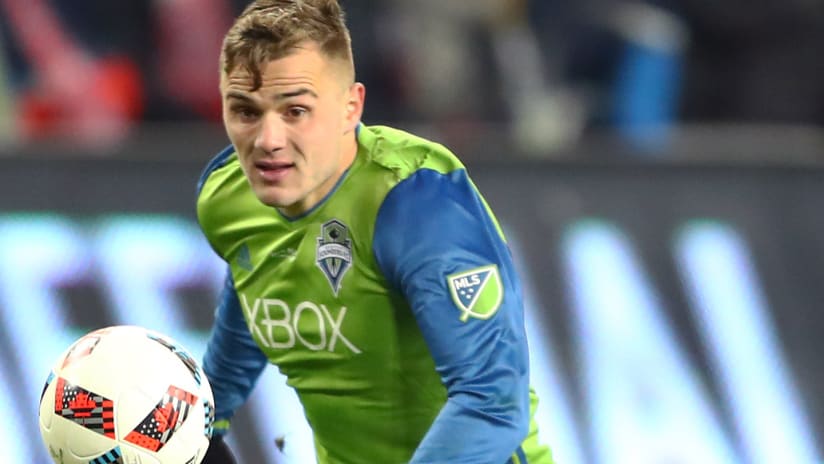It’s the moment every player dreads, but one that most have felt: You take a step, and in a split-second, your world changes. A nanosecond before, everything was normal. Then the pop. Now … now … this can’t be real. How did this happen? This can’t be happening.
During last week's 2018 CONCACAF Champions League opening leg match against Santa Tecla, down in El Salvador, Seattle Sounders forward Jordan Morris took a fall. As soon as he hit the ground, you knew it wasn’t good. No one was within 10 yards when he stumbled. Today, the Sounders confirmed the fears, announcing that Morris has a torn ACL and will miss roughly seven months of action. It’s tough news for a player who spent most of 2017 battling through nagging ankle injuries and only recently started to hit his stride.
How will Morris’s absence impact Seattle?
In the short run, Seattle should be able to handle the adjustment. They have talented pieces who can fill in. That’s the beauty of the Targeted Allocation Money (TAM) era and building squad depth; a team can lose an international-caliber player and still feel OK about their prospects.
Head coach Brian Schmetzer seemed set to stick with a 4-2-3-1 this year, and Morris was an option to play at either wing or forward. On the wing (or central attacking midfield option, depending on what three Schmetzer choose on a given day) the Sounders have Nico Lodeiro, Clint Dempsey, Magnus Wolff Eikrem, Harry Shipp, and Victor Rodriguez, plus younger options in Henry Wingo and Handwalla Bwana. The exact spots don’t mean much in Schmetzer’s system – the attackers are all generally allowed to play and flow however they interpret the game and position – so each of them can play any of the three spots.
With Morris healthy, it was likely to be either Lodeiro-Dempsey-Morris or Eikrem-Lodeiro-Morris; swapping either Dempsey or Eikrem (the 2016 Swedish Allsvenskan player of the year), in for Morris doesn’t change the overall quality that much. Morris can play striker – and has – but that never seemed to be Schmetzer’s preference. Both Will Bruin and Dempsey are more accomplished hold-up players who also link more effectively with runners than Morris. Each would seem to be a better fit with the players behind (especially if Morris were one of those runners).
The longer arc of the season, however, gets murkier. If we look at the main options to fill Morris’s minutes - Lodeiro, Dempsey, Eikrem, Rodriguez, and Shipp - there’s a clear trait missing: None are particularly fast. All have a good burst over a few yards, but none can run by defenders over longer distances. Look at striker, and the problem is exacerbated. Morris provides the pace.
He’s not just fast, he’s “make-the-opponent-think-about-how-fast he is” fast. And while some are quick to mention Morris’s shortcomings, there aren’t actually that many players who have his pace AND more technical ability than he does. To find that costs a lot of money in the transfer market. It’s not so simple to say, “We need pace,” and “We also want to play a certain brand of soccer,” and then go get it.
If the Sounders start hot, as they could given their talent, other teams will eventually adjust. Opponents could start to compress the field and sacrifice the area behind their defenders, knowing the Sounders don’t have anyone to exploit the space with a direct run. It’s always a good feeling for a defender or a defending team if they know they can get as close as possible to the attackers and not have to worry about the space behind them. Without Morris, the Sounders lack an apparent counter. For whatever one thinks of the player, he opens space for his teammates with his mere presence on the field.
Morris’s absence limits the Sounders’ options and, thus, their maximum potential. In this MLS moment, it helps to have flexibility, in either tactics and formation or personnel. A team doesn’t need to shift between a 4-3-3 and 3-5-2 every week, but it usually needs to have a different type of player on the wing depending on the opponent and team need: you'll want a different attacker against the Red Bulls than you will vs. Vancouver. As it stands, Seattle now lack that second dimension.
Without the threat of Morris’s pace, what could Seattle do to add long-term options to their play? One possibility they’ve toyed with in preseason is a 4-4-2 diamond midfield. The diamond puts more numbers around the ball to create an advantage in possession; if you can’t beat them with a single direct run, then maybe you just get really good at passing and combination play.
A diamond can also morph into a 3-5-2, with the base of the diamond acting as an added center back, something that would suit both Gustav Svensson and an aging Ozzie Alonso, allowing the outside backs to fly forward. I hesitate to ever ask a player to act like Dani Alves, but the Brazilian right back proved than an outside back can fulfill the functions of a winger. Kelvin Leerdam and Nouhou (or Waylon Francis) could each provide the pace if Schmetzer decides to get creative and give them openings to advance higher on the field, and in earlier positions.
Morris’s injury might not reveal its full impact early in the season. But if Schmetzer and Garth Lagerway don’t find some suitable replacement speed, the Sounders will likely struggle in their attempt to return to a third straight MLS Cup final.













